Podcast
Questions and Answers
Which of the following is NOT derived from the ectoderm?
Which of the following is NOT derived from the ectoderm?
- Liver (correct)
- Epidermis
- Neural tube
- Lens of eye
What structures are derived from the lateral mesoderm?
What structures are derived from the lateral mesoderm?
- Neural crest
- Connective tissue of the viscera (correct)
- Urogenital system
- Rete testis
Which of the following structures is formed from the endoderm?
Which of the following structures is formed from the endoderm?
- Trachea (correct)
- Muscles of the trunk
- Epidermis
- Spleen
The cranial and sensory ganglia develop from which germ layer?
The cranial and sensory ganglia develop from which germ layer?
What is a derivative of the paraxial mesoderm?
What is a derivative of the paraxial mesoderm?
Which organ is NOT derived from the endoderm?
Which organ is NOT derived from the endoderm?
The connective tissue of the head is primarily derived from which germ layer?
The connective tissue of the head is primarily derived from which germ layer?
Which of the following is formed by the neuroectoderm?
Which of the following is formed by the neuroectoderm?
What component of the urogenital system is derived from the intermediate mesoderm?
What component of the urogenital system is derived from the intermediate mesoderm?
Which part of the embryo is formed by the epiblast?
Which part of the embryo is formed by the epiblast?
Study Notes
Ectoderm
- The ectoderm gives rise to the outer layer of skin (epidermis), hair, nails, and glands of the skin like sweat glands and mammary glands.
- The ectoderm also forms the anterior pituitary gland, the enamel of teeth, structures of the inner ear, the lens of the eye, and the retina.
- The neural tube, a structure that forms along the back of the embryo, develops from the neuroectoderm.
- The central nervous system, including the brain and spinal cord, originates from the neural tube.
- The pineal gland, which is responsible for regulating sleep cycles, and the posterior pituitary gland, which controls hormone release, also develop from neuroectoderm.
- The neural crest, a group of cells that migrate from the neural tube, gives rise to the cranial and sensory ganglia of the nervous system. It also contributes to the medulla of the adrenal glands, pigment cells, cartilage of the pharyngeal arches, and head mesenchyme.
Mesoderm
- The paraxial mesoderm forms the muscles of the head, trunk, and limbs, as well as the skeleton (excluding the skull).
- It contributes to the dermis of the skin and connective tissue of the head.
- The intermediate mesoderm gives rise to the organs of the urogenital system, including the gonads, ducts, and accessory glands. It also forms the connective tissue of the viscera, the serous membranes (pleura, pericardium, peritoneum), the primordial heart, blood and lymphatic cells, the spleen, and the suprarenal (adrenal) cortex.
- The lateral mesoderm contributes to the connective tissue of the viscera, serous membranes, the primordial heart, blood and lymphatic cells, and the suprarenal (adrenal) cortex.
Endoderm
- The endoderm forms the epithelial lining of the trachea, bronchi, and lungs.
- It also forms the epithelium of the gastrointestinal tract, the liver, and the pancreas.
- The endoderm gives rise to the urinary bladder and the urachus, a connection between the bladder and the umbilical cord.
- The endoderm forms the epithelial parts of the pharynx, thyroid gland, tympanic cavity, pharyngotympanic tube, tonsils, and parathyroid glands.
Key Structures and Tissues
- The cranium, commonly known as the skull, protects the brain.
- Dentin, a hard substance, forms the bulk of the tooth.
- The trachea, the windpipe, carries air to and from the lungs.
- The bronchi, branches of the trachea, conduct air to each lung.
- The lungs, the primary organs of respiration, facilitate gas exchange.
- The gastrointestinal tract, also known as the digestive tract, processes food.
- The liver and pancreas, essential digestive organs, contribute to digestion and nutrient absorption.
- The urinary bladder stores urine.
- The urachus, a tube connecting the bladder to the umbilical cord during fetal development, normally closes shortly after birth.
- The pharynx, located in the throat, plays a role in breathing and swallowing.
- The thyroid gland, an endocrine gland, secretes hormones essential for metabolism.
- The tympanic cavity, located in the middle ear, contributes to hearing.
- The pharyngotympanic tube, also known as the Eustachian tube, connects the middle ear to the back of the throat.
- The tonsils, lymphoid tissues, function in immune defense.
- The parathyroid glands, endocrine glands, regulate calcium levels in the blood.
Trilaminar Embryonic Disc
- The trilaminar embryonic disc is a critical structure in early embryonic development, consisting of the three germ layers: ectoderm, mesoderm, and endoderm.
- The epiblast and embryoblast are key parts of the embryonic disc.
- These germ layers give rise to all the tissues and organs of the body during embryonic development.
Studying That Suits You
Use AI to generate personalized quizzes and flashcards to suit your learning preferences.
Description
Explore the fascinating roles of the ectoderm and mesoderm in human development. This quiz highlights how these layers contribute to skin, nervous system structures, and more, detailing their importance in embryology. Test your knowledge on how these layers develop and their functions.



